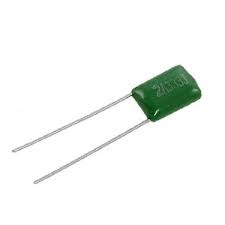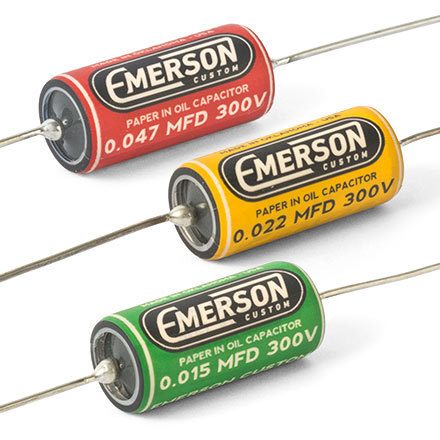Tone Capacitors are the MOST misunderstood component in a guitar.
The easiest way to think of a tone capacitor is in the typical tone circuit they are a HIGH FREQUENCY REMOVAL (OR BLOCKING Device in the case of a BassTamer) device. The SMALLER the capacitor (like .022, .015 or less) the less the treble is removed when in a normal tone circuit. This is because the filter frequency shifts higher so more high frequency remains unfiltered. If the cap value was really small, the filter frequency would be so high that no audible signal would be affected.
Importantly, a passive circuits do NOT add any bass, PERIOD. They filter out (shunt to ground) or block (if in series) frequencies.
In general the smaller the value, the more higher frequencies can get through. It shifts the cutoff higher.
The list below shows typical values and how they sound in general.
TYPICAL VALUES
In Micro Farads which is 1000 NF (nano farads) – uF means Micro Farads.
- .062 uF – MEGA dark, not sure what you’d do with this..
- .047 µF – Probably as big as you’d want to go – Loses treble quick – lower rolloff – original stratocaster value
- .033 µF – Less common – Darker, less treble quicker
- .022 µF – Very common, especially on Modern Stratocasters
- .015 µF – Very mild cut actually sounds like a dark humbucker if all off, slightly tone modifying.)
- .010 uF – The lowest I use, however, very usable, but lots of treble left. It removes the very top frequencies at the upper range
- .0068 uF – I sometimes use this as a “trim” cap in parallel to fine tune the tone response, By itself it’s not all that useful because it frequency cutoff would be too high.

AC vs DC signals
The basic concept of any capacitor is to act as a “temporary” battery with 2 or more plates and a dielectric material between them. The voltage (a really REALLY small AC from a pickup) appears across the plates. Large plates let lower frequencies through whereas smaller plates let only higher frequencies through.
Capacitors will not let DC signal go through them, they will match that DC value with an equal and opposite value.
However, all AC signals (a signal that change direction constantly) will “pass” through a capacitor at various amounts depending on the capacitance.
Passive guitar tone circuits work by blocking lower frequency values and letting higher frequencies pass though.

Ultimately what is MOST important is the VALUE of the capacitor which is usually expressed in MICROFARADS, or uF. Players argue obsessively about one capacitor material -vs- another but I’ll completely bypass that argument, because at guitar frequencies and voltages it’s an artistic choice and not based on significant measurable differences in capacitance. I like orange drop because they look cool but I’m quite happy with Polyethylene Mylar Film as well. Some capacitors types are prone to leakage but a guitar circuit isn’t one that requires a critical frequency stability like an oscillator for example, so this is not an issue unless it completely fails, which in my experience, at a guitar low voltage is might as well be never because the capacitor isn’t under much stress like a high voltage circuit.
And also, we are talking about VERY VERY low voltage compared to a 100V+ Cap typically used (which is serious overkill but doesn’t hurt anything).
Also, a difference of 10% in tolerance is basically unperceivable to the human ear.
Cutoff Point (Knee)
Capacitors operate on a knee so the knee shifts when the capacitance changes. As you get lower in capacitance the higher the “Pass” frequency (shunt to ground on an typical tone control). They are essentially a passive High Pass “roll off” filter (unless in a resonant circuit).
Resistance and Inductance, a more complete model
The resistance (and even some inductance) forms a more complete DETAILED picture but you don’t need to know all these to select the size of cap you want. Otherwise you’ll need a course in circuit theory, which is interesting, but time consuming and very dry.
There a MANY many types and manufacturers of capacitors. If you spend a bunch of money for one, you are paying for an artistic choice. But we are artists right?

More About Resistance
Typical Stratocaster pots (tone potentiometer) values are 250K for tone pots and single coils pickups. Sometimes 500K to 1Meg with Humbuckers or some “noiseless stacked coil pickups).
What the resistor does (in simple terms) is they are a variable “Throttle” to ANY signal (via resistance) so less signal gets to go through the capacitor to be shunted to ground when the tone is all the way on (most resistance). If a tone pot is full on then there is a 250K resistor across the pickup. If the pot is full off, frequencies above the “Knee” gets shunted to ground because the pickup now sees effectively “0” resistance for those frequencies.
It’s important to note that there is an interaction with the “loading” value of a tone pot on the pickup. The lower the tone pot value, the more the pickup is loaded, and this effect the frequency response of the pickup selected by lowering both the Q and the pickup peak frequency.
No Load Pots
Very cool I love these, they effectively put infinite resistance between the cap and output when fully on (and notched). That effectively takes it (and the resistor) out of the circuit. This will slightly brighten up any pickup. They have a notch where there is no resistance. If you use modeling or lots of pedals, quite of bit of the nuance of this will be complete hidden by the change in frequency content of the modeling or pedals.
Favorite Caps and Dark Caps
I like the ranges from .022 to .010. I rarely use the dark dark roll off of a .047 uF Cap and never anything larger. Note that if you use a larger resistance pot, the larger cap is more useful.
Fender
Fender used to use Ceramics but now brown colored Film Polyethylene is the choice of the day for almost all Stratocasters (and usually .022uf value). On some vintage based serious they will use other types like ceramics, orange drops (which is a film cap) and their own barrel looking film cap (looks totally cool).
Bass Tamer Plug
The BassTamer circuit is a really fun circuit I use it to let the top end through and block lower frequencies. After I figured this out and was researching other values for bass controls and I found out that Leo messed around with this idea, not the same values, but MANY YEARS earlier than me. Go Leo and guitar engineering dinosaurs, you paved the way more than we could even guess. It never made it into mainstream strats. However, other manufacturers have done it.
Capacitor material
The material of a capacitor has little auditory effect on the sound of a pickup except for it’s value. There are 2 basic types of construction used with guitar caps – Film and Ceramic – Polypropylene is the most typical dielectric used for Film caps.
Electrolytic caps are NOT used for guitar tone circuits, mostly because they are polarized. High voltage caps with guitars are generally serious overkill because the voltage in guitars generated by pickups is in millivolts and in the audio range 20-20K (most ears conk out about 16K and less as you age), so switching speed and other intrinsic values of a cap isn’t an issue. Some caps look much groovier than other ones, so that might drive your choice, Orange Drops really look cool as do some barrel caps
Another thing to keep in mind is that the ear is NOT linear in it’s response, and that also effect how you personally might hear the “roll off” of a particular resistive/capacitor arrangement.
This link has some great detail on dielectrics and basic circuit info and some calcs.
Treble Bleed
Cruise to this page to get Treble Bleed info